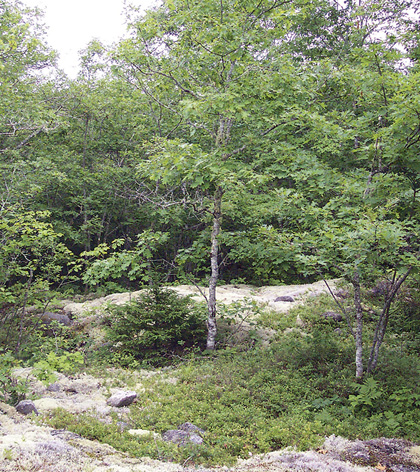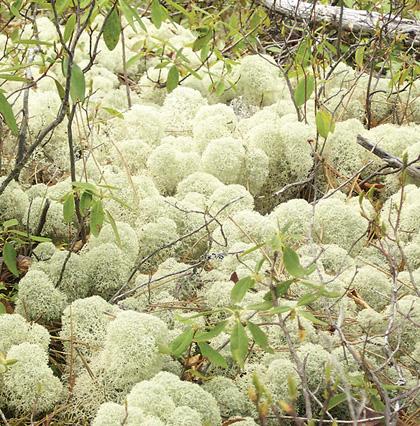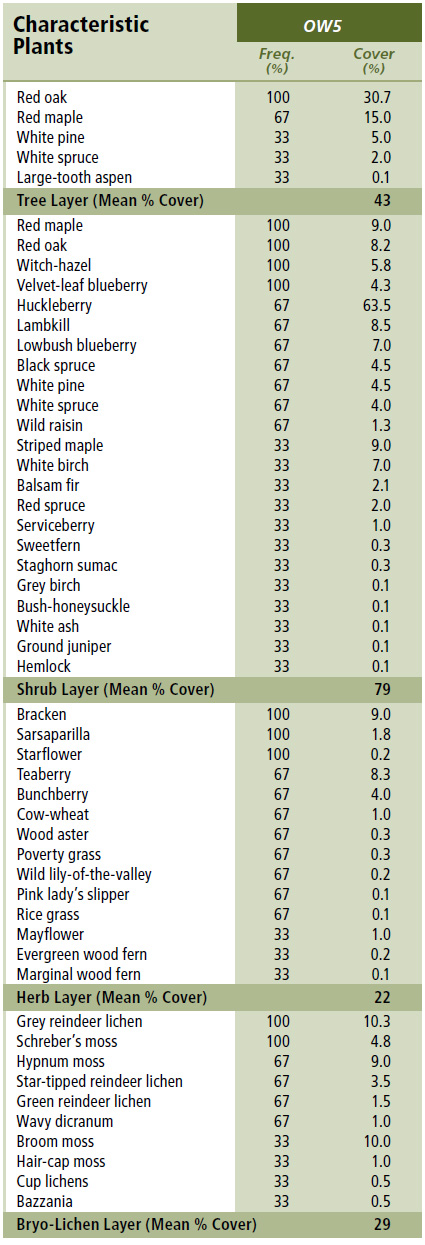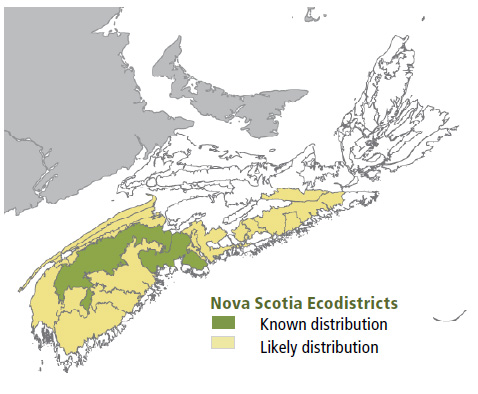
Forest Vegetation types - OW5
OW5 — Red oak / Huckleberry / Cow-wheat – Rice grass / Reindeer lichen
Quercus rubra / Gaylussacia baccata / Melampyrum lineare – Oryzopsis asperifolia / Cladina spp.
 |
Moses Mountain, Hants County |
Concept: This relatively uncommon ecosystem develops on acidic glacial soil and or exposed bedrock. It is characterized by an open canopy of red oak and by dense huckleberry cover. The ecosystem has been called a wooded barren or savanna, and is often found in areas where there is an abrupt change in relief. Many occurrences are adjacent to lakes or on steep ridges or sharply rounded crests.
Vegetation: Red oak and lesser red maple dominate the open deciduous canopy. In southwestern Nova Scotia, black cherry may be a frequent but minor component of stand structure. The well-developed understory usually includes abundant huckleberry, although lambkill cover may be relatively abundant in some occurrences. Other important shrubs include witch-hazel, lowbush blueberry and wild raisin. Herbaceous species abundance and richness is reduced, but species characteristic of open dry forest (e.g. bracken, mayflower, cow-wheat, rice grass) are well represented. Reindeer lichens are abundant in some occurrences.
Environmental Setting: The OW5 ecosystem may occur on rock ridges but most occurrences are on upper slopes and crests of thin glacial deposits. Sites have high exposure and moderate to high surface stoniness; microtopography is low. This Vegetation Type (VT) is found across the Western ecoregion and in parts of the Annapolis Valley ecodistrict. OW5 is often found interspersed with IH2 (Red oak – Red maple / Witch-hazel). The VT is also scattered across southern and eastern New Brunswick.
Successional Dynamics: The woodland occurs as an early to mid-successional phase. General successional relationships are poorly understood, but the ecosystem is expected to persist as an edaphic climax, because dry, nutrient very poor soils generally prevent succession to other VTs. The woodland is maintained by tree senescence and windthrow, but many occurrences, particularly those on glacial soils, originate with fire.
Ecological Features: Red oak / Huckleberry / Cow-wheat – Rice grass / Reindeer lichen woodlands are under sampled and poorly understood in Nova Scotia. This small patch ecosystem is one of our most temperate woodlands. It is somewhat uncommon in Nova Scotia, and much rarer in New Brunswick. Analyses of eastern Canadian forests and woodlands have not yet addressed this VT, but early comparisons indicate the ecosystem may be restricted to the Maritimes, presenting important conservation challenges. This ecosystem supports unique habitat conditions, but associated animal, plant and lichen species are undocumented. It typically features a very open canopy and high shrub and lichen cover. Productivity, tree age, canopy height and old growth potential are all low.
 |
| Star-tipped reindeer lichen |
Distinguishing Features: Red oak is diagnostic of this hardwood woodland, often with red maple, exposed bedrock and prominent reindeer lichen and huckleberry cover. Witch-hazel is common.
| Slope Position: | Upper7 Crest3 |
Surface Stoniness: |
(Very - Excessively)7 (Moderately)3 |
Bedrock Outcrop: |
(Slightly - Moderately)7 (Very - Excessively)3 |
Elevation Range: |
107 - 175m |
Slope Gradient: |
Gentle7 Moderate3 |
Aspect: |
North3 South7 |
Exposure: |
Exposed7 Moderate3 |
Microtopography: |
Level7 Slightly3 |
Drainage: |
Rapid7 Well3 |
Soil Type: |
ST157 ST23 |
Parent Material: |
Glacial till7 Till/Bedrock3 |
Rooting Depth (cm): |
(<30)7 nd3 |
Duff Thickness (cm): |
(0-5)7 (11-20)3 |

